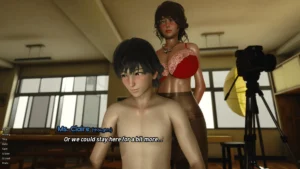
The Sin Within
Play The Sin Within
The Sin Within review
Exploring Gameplay, Story, and Player Insights of The Sin Within
The Sin Within is a distinctive interactive game that blends narrative-driven gameplay with adult themes, offering players a unique experience that goes beyond typical titles in its genre. This article explores the core aspects of The Sin Within, including its storyline, gameplay mechanics, and what makes it stand out. Whether you’re curious about its design or looking for practical tips to navigate the game, this guide provides a comprehensive overview to enhance your understanding and enjoyment.
Understanding The Sin Within: Story and Gameplay
What Is The Sin Within About?
Let me tell you, the first time I booted up The Sin Within, I was expecting one kind of experience, but I got something entirely different—and far more profound. 🎭 If you’re tired of shallow plots, this game is a breath of fresh air. So, what is The Sin Within game story really about? At its heart, it’s a gripping psychological journey into the life of Alex, a successful architect whose seemingly perfect world begins to crumble after a series of strange, supernatural events. The setting is a beautifully rendered, rain-slicked metropolis that feels both familiar and eerily off, a character in its own right.
The narrative kicks off with Alex discovering an old, cryptic journal belonging to a previous tenant of his new apartment. This isn’t just a simple “find the clues” setup; the journal’s entries start to blur the lines between the past and the present, forcing Alex to confront hidden truths about the city and, more importantly, about himself. The core of The Sin Within game story is this internal conflict—the “sins” or unresolved regrets we all carry and how they shape our reality. It’s a masterclass in building tension, making you question what is real and what is a projection of the protagonist’s fractured psyche. I remember a specific moment late at night where a choice I made about confronting a memory genuinely left me pausing the game to think about my own past decisions. It’s that kind of powerful, reflective storytelling.
This deep, character-driven approach is what truly defines The Sin Within as a standout title. The plot isn’t just something you watch; it’s something you actively dissect and influence. You’re not just playing a game; you’re unraveling a human soul. 🧩 This foundation is crucial because every single detail of the world feeds back into the central narrative, making the The Sin Within gameplay mechanics feel like a natural extension of the story, not a separate entity.
Core Gameplay Mechanics Explained
Alright, let’s get into the nuts and bolts of how you actually interact with this world. If you’re wondering how to play The Sin Within, the answer is both simple and complex. On the surface, you explore detailed environments, interact with objects, and converse with a cast of nuanced characters. But the real magic lies beneath. The primary The Sin Within gameplay mechanics are built on a foundation of interactive adult game choices. This isn’t about choosing a simple dialogue option; it’s about making decisions that have weight and consequence.
The game uses a unique “Empathy System.” During conversations, you don’t just pick what to say; you also control the intensity and tone of your delivery. A gentle reassurance can lead to a character opening up, while a forceful demand might shut them down permanently. I learned this the hard way when I tried to push a fragile character for information too quickly and completely altered their storyline for the rest of my playthrough. 😅 Another key mechanic is the “Memory Dive,” where you explore Alex’s subconscious. These segments are visually stunning and play more like an interactive puzzle, where you manipulate memories to uncover the truth. The unique features The Sin Within introduces, like this blend of psychological exploration and traditional adventure gameplay, are what set it apart.
To give you a clearer picture of how it stacks up against other titles in the genre, here’s a breakdown:
| Feature | The Sin Within | Similar Narrative Titles |
|---|---|---|
| Choice System | Empathy & Intensity-based dialogue | Primarily binary (Good/Evil) choices |
| Narrative Integration | Gameplay (e.g., Memory Dives) is part of the story | Gameplay and story often segmented |
| Player Agency | Choices alter character relationships & world state subtly | Choices often lead to major, flagged branching paths |
| Pacing | Slow-burn, psychological tension | Often faster-paced, action-oriented |
This table highlights why the The Sin Within gameplay mechanics feel so innovative. They are deeply woven into the fabric of the experience, refusing to treat player interaction as a mere menu selection. It’s a hands-on approach to storytelling that demands your emotional investment. 🙌
How Player Choices Shape the Experience
This is where The Sin Within truly shines and earns its place among the best narrative-driven adult games. The player decision impact The Sin Within delivers is not an exaggeration; it is the core of the entire experience. We’re not talking about a simple “ending A, B, or C” scenario. The game employs a sophisticated web of cause and effect where even the smallest, seemingly insignificant action can ripple outward in unexpected ways.
For example, early on, you find a stray cat in an alley. You can choose to ignore it, shoo it away, or give it a bit of food. I didn’t think much of it—it was just a cat, right? Wrong. 🤯 Several hours later, that same cat appeared during a critical, tense moment, affecting an NPC’s behavior and opening up a dialogue option I wouldn’t have had otherwise. This level of detail creates an incredible sense that the world is alive and responsive to your presence. The player decision impact The Sin Within is often subtle, changing the tone of a relationship or the availability of information, rather than just locking you out of a content branch.
This design philosophy is what makes the interactive adult game choices so compelling. They force you to think about your actions not in terms of “what gets me the best reward,” but “what feels true to the character I’m helping to shape?” Do you encourage Alex to face his demons head-on, or to retreat into denial? Your choices directly influence his mental state, which is reflected in the game’s environment and even the reliability of the narrative itself. Hallucinations might become more frequent, or the world might appear brighter and more hopeful.
Pro Tip: Don’t reload saves to “fix” a choice you regret on your first playthrough. The beauty of The Sin Within is living with the consequences. It makes the story feel uniquely yours and massively boosts replayability.
I’ve played through three times, and each run felt distinctly different because I focused on different aspects of Alex’s personality. The unique features The Sin Within offers, particularly this nuanced consequence system, ensure that your journey is personal. It understands that adulthood isn’t about clear-cut good and evil; it’s about nuanced decisions with complex outcomes. This profound player decision impact The Sin Within creates a deeply personalized story that will linger with you long after you’ve put the controller down. It’s more than a game; it’s a reflection. 💡
The Sin Within offers a compelling blend of narrative depth and interactive gameplay that sets it apart in its category. Its emphasis on player choice and story immersion creates a personalized experience that many find engaging and memorable. Whether you’re new to this type of game or looking to deepen your involvement, understanding its core mechanics and storyline can greatly enhance your enjoyment. Dive in and explore the layers of The Sin Within to discover what makes it truly unique.
























